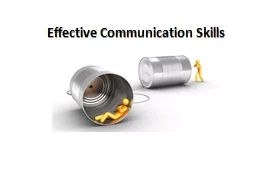

Objectives Define and understand communication and the communication process List and overcome the filtersbarriers in a communication process Practice active listening Tips to improve verbal and non verbal communication ID: 599192
Download Presentation The PPT/PDF document "Effective Communication Skills" is the property of its rightful owner. Permission is granted to download and print the materials on this web site for personal, non-commercial use only, and to display it on your personal computer provided you do not modify the materials and that you retain all copyright notices contained in the materials. By downloading content from our website, you accept the terms of this agreement.
Slide1
Effective Communication SkillsSlide2
Objectives
Define and understand communication and the communication process
List and overcome the filters/barriers in a communication process
Practice active listening
Tips to improve verbal and non verbal communicationSlide3
What are the most common ways we communicate?
Spoken Word
Written Word
Visual Images
Body LanguageSlide4
What is Communication?
Communication is the transmission of an idea or feeling so that the sender and receiver share the same understanding.
Communication is not a mysterious process.
It takes place when the ideas from your mind are transferred to another’s and arrive intact, complete, and coherent.Slide5
The Communication Process
SENDER
(encodes)
RECEIVER
(decodes)
Barrier
Barrier
Medium
Feedback/ResponseSlide6
Types of Communication
(
One-way
)Slide7
Types of Communication
(Two
-way
)Slide8
Types of Communication
(One to Many)Slide9
Components
of Communication
Vocal communication
Verbal Communication
Non-verbal communicationSlide10
Features of Effective Communication
Active Listening
Eye contact
Posture
Simple language
Questioning skillsSlide11
Benefits of effective communication
Quicker problem solving
Better decision making
Steady work flow
Strong business relations
Better professional imageSlide12
Barriers to communication
Distractions
Use of jargon
Poor listening skills
Cultural differences
Language differences
Emotions
Assumptions/Misconceptions
Inappropriate medium
NoiseSlide13
Hearing
Vs
Listening
Hearing
– Physical process, natural, passive
Listening
– Physical as well
as mental process, active,
learned process, a skill
Listening is hard.
You must choose to participate in the process of listening.Slide14
Hearing
Choosing
Understanding
Responding
The reception of sound.
The act of choosing to focus attention on the message.
Deciding what the message means to you.
Your reaction to the message. It can be emotional and intellectual.
Steps in the listening process
Definition of listening:
It is a
physical
and
psychological
process that involves
choosing
to listen,
understanding,
and
responding
to symbolic messages from others.
Your knowledge, attitudes, values, beliefs and self-concept influences your perception.
You first respond emotionally, then intellectually. Then you decide how to respond.
Your own needs, interests, attitudes, and knowledge affects your choice to pay attention.
Not everyone hears the same way. Men actually prefer certain frequencies.Slide15
placating
filtering
derailing
comparing
mind reading
rehearsing
dreaming
sparring
identifying
judging
being right
BLOCKS TO LISTENINGSlide16
Comparing
constantly comparing yourself to the other person, checking to see if you measure up in terms of intelligence, wit, emotional stability, competence, or even level of suffering
or
children's achievements.
Mind Reading
what you think someone "really means" (based primarily on your own feelings, assumptions, or hunches) than to what he or she is actually saying.
Rehearsing
plan
ning
your response to what someone is saying to you while the other person is still speaking.
Filtering
tun
ing
out certain topics or you may hear only certain things and tune everything else out
,
a
ny
possible hint of unhappiness, no matter what he actually
sa
ys
. Slide17
Judging
if you decide ahead of time that the other person is not worth hearing (because he or she is "stupid," "
crazy,"'"hypocritical
," or " immature"), and that you will therefore listen only in order to confirm your opinion.
Dreaming
you pay only a fraction of your attention to the person talking; inside, your thoughts are wandering elsewhere.
identifying
whatever you hear from the other person triggers memories of your own similar experiences, and you can't wait to.
jump
into your own story.
Advising
Jumping in with advice when the other person has barely stopped talking (or before) Slide18
Sparring
If you listen only long enough to find something to disagree with, and then assert your position-—regardless of what the other person says.
Being Right
If you
want
to prove that you're right or to avoid the suggestion that you're wrong— including lying, shouting, twisting the facts, changing the subject, making excuses, and accusing
Derailing
chang
ing
the subject or make a joke whenever you become bored or uncomfortable with
the
conversation.
Placating
being
so concerned with being nice, agreeable, or liked that without really listening you agree with everything being said. Slide19
Active Listening
The process of recognizing, understanding, and
accurately interpreting communicated messages
and responding to spoken and/or nonverbal
messages.Slide20
Tips to become a better listener
Don’t talk – listen.
Don’t jump to conclusions.
Listen between the lines.
Ask questions/paraphrase.
Don’t get distracted by the environment.
Keep an open mind.
Be willing to listen to someone else’s point of view and ideas.
Provide feedback.Take advantage of your brain power.Slide21
Improving Verbal Communication-Tips
Eliminate Noise
Get Feedback – Verbal & Body Signals
Speak Slowly & Rephrase your sentence
Don’t Talk down to the other person
Listen Carefully & PatientlySlide22
Improving Body Language - Tips
Keep appropriate distance
Touch only when appropriate
Take care of your appearance
Be aware - people may give false cues
Maintain eye contact
Smile genuinely